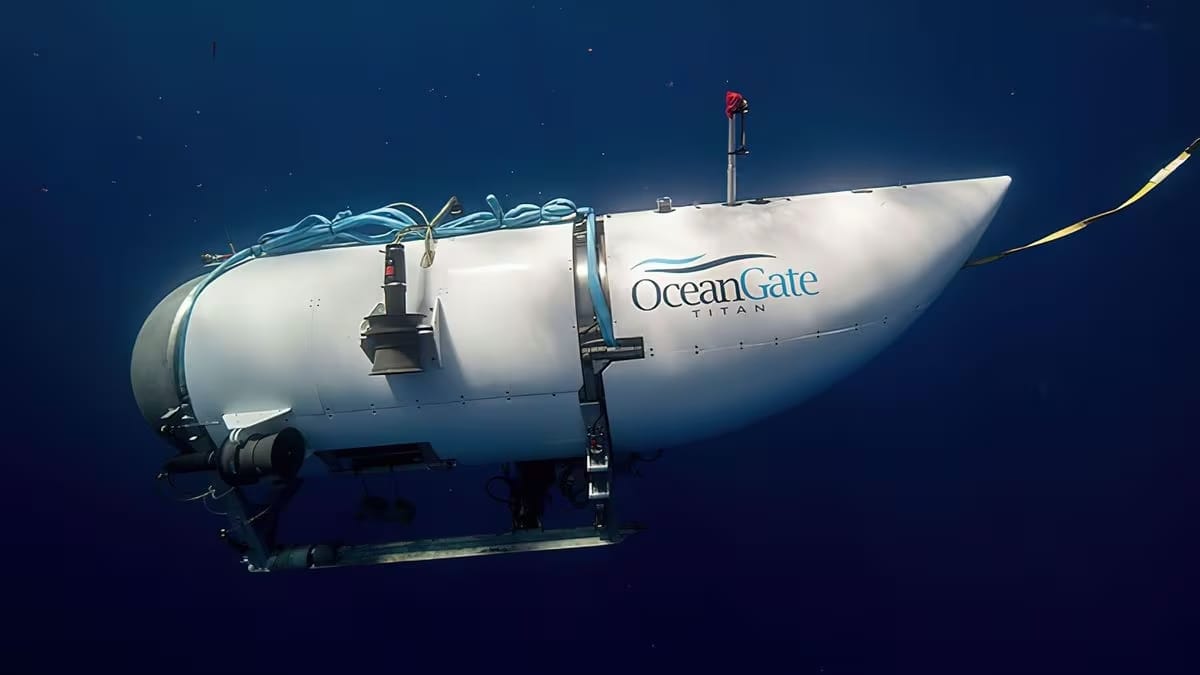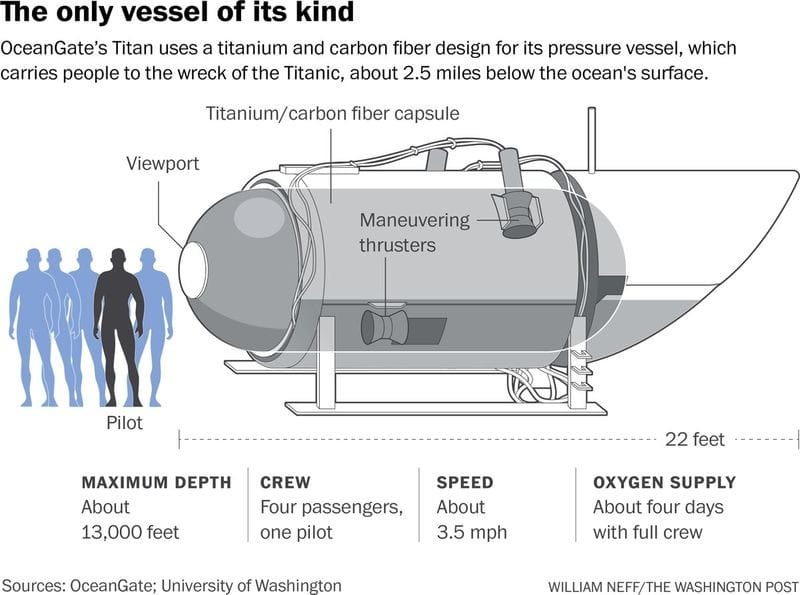The OceanGate Titan Tragedy
The Titan submersible, made by OceanGate, was built to handle the pressure 4,000 meters under the sea.

Introduction
In the vast expanse of the ocean's depths, where mysteries lie shrouded in darkness and pressure, humanity's quest for exploration often dances perilously close to disaster. The OceanGate Titan incident stands as a chilling testament to the dangers that accompany our fascination with the unknown. In this blog, we embark on a journey into the heart of this tragedy, dissecting its causes, unraveling its legal implications, and pondering the future of deep-sea exploration.
A Voyage Gone Wrong
In a world where people are more and more interested in exploring what's deep under the sea, a tragic event happened with a special underwater vehicle called the Titan. It's run by a company called OceanGate, Inc. This sad incident, where five brave explorers lost their lives, has made everyone question how safe it is to explore deep underwater, and whether the rules for building these vehicles are good enough. It also brings up legal questions when things go wrong on these dangerous trips.
The Titan was supposed to do something historic: dive really deep to where the Titanic sank, a ship that's fascinated people for over a hundred years. But instead of making history, the Titan had a terrible accident. The Titan, piloted by OceanGate Expeditions CEO Stockton Rush, suffered a catastrophic implosion during its descent, leading to the instant loss of all onboard.
In the aftermath of the disaster, the spotlight has turned to the controversial practices of OceanGate and the unconventional design of the Titan. Critics argue that the company ignored established safety protocols and cut corners during the submersible's construction, which may have contributed to the catastrophic incident.
The Construction of the Titan
The Titan submersible, made by OceanGate, was built to handle the pressure 4,000 meters under the sea. It was named after Saturn's moon, known for its tough conditions. The submersible was made of carbon fiber with titanium parts and covered in composite cladding sealed with epoxy. This was a big change from the usual way of making submarines, which usually involved steel.

The CEO of OceanGate, Stockton Rush, said in a 2021 interview that he didn't follow all the rules when making the submersible. He especially mentioned using carbon fiber and titanium, which isn't what people normally use for submarines. Some people didn't like this decision. Famous filmmaker and ocean explorer James Cameron didn't like the Titan's design either. He thought using carbon fiber was a bad idea and warned people about the risks of going deep in a submersible made like this. A former employee and a rich digital marketing executive were worried about the submersible's safety too. The ex-employee said they were fired for bringing up safety problems with the Titan's construction. Chris Brown, the executive, also backed out of the expedition, saying OceanGate was taking too many risks with how they built the submersible.
Legal Implications and Scenarios
After any tragic event like the OceanGate Titan incident, legal matters become a big concern. These usually revolve around two main things: whether there was negligence and the waivers signed by the passengers.
The passengers killed were Pakistani businessman and his son, Shahzada and Suleman Dawood; British businessman Hamish Harding; French diver Paul-Henri Nargeolet; and Stockton Rush, the CEO of the vessel's operator, OceanGate Expeditions.

Negligence means not being as careful as a reasonable person would be in the same situation. It's a key idea in most personal injury cases, including those that might come from the Titan disaster. There's a big difference between simple negligence and gross negligence. Simple negligence might be small mistakes or errors in judgment. But gross negligence is much worse. It's when someone is really careless and puts others in danger, even when they know it could cause harm.
Considering the safety worries before the Titan accident and Rush admitting to breaking rules when building the submarine, it's possible that people might argue there was gross negligence. If they're right, it could mean big financial trouble for OceanGate.
The Role of Waivers
Before going on the Titan, passengers signed waivers. These said they knew about the risks and agreed not to blame OceanGate for certain things. These waivers are common in risky activities and can protect companies from lawsuits for simple negligence. But waivers don't give total protection. They can't stop lawsuits for gross negligence. The law says people shouldn't have to give up their right to take legal action if a company is extremely careless and causes harm or death.
Balancing Innovation and Caution

The OceanGate Titan tragedy underscores a critical dilemma at the core of deep-sea exploration: the delicate balance between innovation and safety. The unconventional design choices made in the construction of the Titan, such as the use of carbon fiber and titanium, highlight the inherent risks associated with pushing the boundaries of technology in pursuit of exploration. While these materials may offer potential advantages, they also introduce new complexities and vulnerabilities, as demonstrated by the catastrophic implosion of the submersible during its descent. This tragic event serves as a sobering reminder of the profound responsibility inherent in the quest to unlock the mysteries of the ocean's depths.
In response to the Titan disaster, the industry must undergo a comprehensive reevaluation of its safety standards and practices. The warnings and objections raised before the tragedy by both internal and external stakeholders serve as poignant reminders of the need for a more proactive approach to risk management. By fostering a culture of accountability, transparency, and collaboration, the industry can work towards developing robust safety protocols that prioritize the protection of human life without compromising the spirit of exploration and innovation. It is imperative that lessons are learned from this tragedy to prevent similar incidents in the future.
As we navigate the uncharted waters of deep-sea exploration, it is essential to recognize that safety must remain paramount. The pursuit of knowledge and discovery should not come at the expense of human lives. By embracing a holistic approach that balances the drive for innovation with a steadfast commitment to safety, we can forge a path forward that is both ambitious and ethically responsible. The OceanGate Titan incident serves as a poignant reminder of the challenges and responsibilities inherent in exploring the unknown, urging us to tread carefully as we continue to chart new territories beneath the ocean's surface.
A Wake-Up Call
The OceanGate Titan disaster serves as a sobering wake-up call for the industry and regulators alike. It lays bare the perils of neglecting safety in the pursuit of innovation. As we reflect on this tragedy, we must heed its lessons and take proactive steps to prevent similar incidents in the future.
The quest for exploration is noble, but it must be tempered with a relentless focus on safety. The ocean's depths, with their mysteries and wonders, demand our respect and caution. Let the OceanGate Titan tragedy stand as a beacon guiding us toward safer, more responsible exploration of the deep.
Conclusion
In conclusion, the OceanGate Titan incident serves as a stark reminder of the delicate balance between innovation and safety in the realm of deep-sea exploration. As we navigate the murky waters of the ocean's depths, let us do so with a renewed commitment to protecting human life and preserving the wonders that lie beneath.





